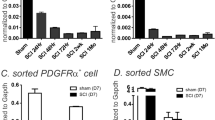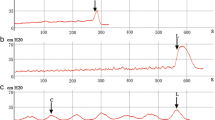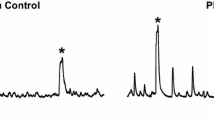Abstract
Transient receptor potential cation channel subfamily M member 4 (TRPM4) has been shown to play a key role in detrusor contractility under physiological conditions. In this study, we investigated the potential role of TRPM4 in detrusor overactivity following spinal cord transection (SCT) in mice. TRPM4 expression and function were evaluated in bladder tissue with or without the mucosa from spinal intact (SI) and SCT female mice (T8-T9 vertebra; 1–28 days post SCT) using PCR, western blot, immunohistochemistry, and muscle strip contractility techniques. TRPM4 was expressed in the urothelium (UT) and detrusor smooth muscle (DSM) and was upregulated after SCT. Expression levels peaked 3–7 days post SCT in both the UT and DSM. Pharmacological block of TRPM4 with the antagonist, 9-Phenanthrol (30 μM) greatly reduced spontaneous phasic activity that developed after SCT, regardless of the presence or absence of the mucosa. Detrusor overactivity following spinal cord injury leads to incontinence and/or renal impairment and represents a major health problem for which current treatments are not satisfactory. Augmented TRPM4 expression in the bladder after chronic SCT supports the hypothesis that TRPM4 channels play a role in DSM overactivity following SCT. Inhibition of TRPM4 may be beneficial for improving detrusor overactivity in SCI.




Similar content being viewed by others
References
Abdel-Karim AM, Bialecki RA, Elhilali MM (2002) Effects of ZD6169 and ZD0947, 2 potassium adenosine triphosphate channel openers, on bladder function of spinalized rats. J Urol 168:837–842
Akino H et al (2008) Spontaneous contractions of the pig urinary bladder: the effect of ATP-sensitive potassium channels and the role of the mucosa. BJU Int 102:1168–1174. https://doi.org/10.1111/j.1464-410X.2008.07782.x
Andersson KE, Arner A (2004) Urinary bladder contraction and relaxation: physiology and pathophysiology. Physiol Rev 84:935–986. https://doi.org/10.1152/physrev.00038.2003
Andersson KE, Wein AJ (2004) Pharmacology of the lower urinary tract: basis for current and future treatments of urinary incontinence. Pharmacol Rev 56:581–631. https://doi.org/10.1124/pr.56.4.4
Apodaca G, Kiss S, Ruiz W, Meyers S, Zeidel M, Birder L (2003) Disruption of bladder epithelium barrier function after spinal cord injury. Am J Physiol Ren Physiol 284:F966–F976. https://doi.org/10.1152/ajprenal.00359.2002
Artim DE, Kullmann FA, Daugherty SL, Bupp E, Edwards CL, de Groat WC (2011) Developmental and spinal cord injury-induced changes in nitric oxide-mediated inhibition in rat urinary bladder. Neurourol Urodyn 30:1666–1674. https://doi.org/10.1002/nau.21143
Bijos DA, Drake MJ, Vahabi B (2014) Anoctamin-1 in the juvenile rat urinary bladder. PloS One 9:e106190. https://doi.org/10.1371/journal.pone.0106190
Birder LA (2006) Role of the urothelium in urinary bladder dysfunction following spinal cord injury. Prog Brain Res 152:135–146. https://doi.org/10.1016/S0079-6123(05)52009-0
Birder L, Andersson KE (2013) Urothelial signaling. Physiol Rev 93:653–680. https://doi.org/10.1152/physrev.00030.2012
Bouhy D, Ghasemlou N, Lively S, Redensek A, Rathore KI, Schlichter LC, David S (2011) Inhibition of the ca(2)(+)-dependent K(+) channel, KCNN4/KCa3.1, improves tissue protection and locomotor recovery after spinal cord injury. J Neurosci 31:16298–16308. https://doi.org/10.1523/JNEUROSCI.0047-11.2011
Burris SK, Wang Q, Bulley S, Neeb ZP, Jaggar JH (2015) 9-Phenanthrol inhibits recombinant and arterial myocyte TMEM16A channels. Br J Pharmacol 172:2459–2468. https://doi.org/10.1111/bph.13077
Cameron AP (2016) Medical management of neurogenic bladder with oral therapy. Transl Androl Urol 5:51–62. https://doi.org/10.3978/j.issn.2223-4683.2015.12.07
Chen B et al (2018) Non-invasive multimodality imaging directly shows TRPM4 inhibition ameliorates stroke reperfusion injury. Transl Stroke Res. https://doi.org/10.1007/s12975-018-0621-3
de Groat WC, Yoshimura N (2010) Changes in afferent activity after spinal cord injury. Neurourol Urodyn 29:63–76. https://doi.org/10.1002/nau.20761
de Groat WC, Yoshimura N (2012) Plasticity in reflex pathways to the lower urinary tract following spinal cord injury. Exp Neurol 235:123–132. https://doi.org/10.1016/j.expneurol.2011.05.003
de Groat WC, Griffiths D, Yoshimura N (2015) Neural control of the lower urinary tract. Compr Physiol 5:327–396. https://doi.org/10.1002/cphy.c130056
Du S, Araki I, Mikami Y, Zakoji H, Beppu M, Yoshiyama M, Takeda M (2007) Amiloride-sensitive ion channels in urinary bladder epithelium involved in mechanosensory transduction by modulating stretch-evoked adenosine triphosphate release. Urology 69:590–595. https://doi.org/10.1016/j.urology.2007.01.039
Earley S (2013) TRPM4 channels in smooth muscle function. Pflugers Arch 465:1223–1231. https://doi.org/10.1007/s00424-013-1250-z
Elzayat E, Khaled S, Kashiwabara T, Elhilali M, Corcos J (2006) Effect of the potassium channel opener WAY-133537 on the overactive bladder of spinalized rats. Neurourol Urodyn 25:808–814. https://doi.org/10.1002/nau.20284
Ferrera L, Caputo A, Ubby I, Bussani E, Zegarra-Moran O, Ravazzolo R, Pagani F, Galietta LJV (2009) Regulation of TMEM16A chloride channel properties by alternative splicing. J Biol Chem 284:33360–33368. https://doi.org/10.1074/jbc.M109.046607
Fry CH, Vahabi B (2016) The role of the mucosa in normal and abnormal bladder function. Basic Clin Pharmacol Toxicol 119(Suppl 3):57–62. https://doi.org/10.1111/bcpt.12626
Fry CH, Young JS, Jabr RI, McCarthy C, Ikeda Y, Kanai AJ (2012) Modulation of spontaneous activity in the overactive bladder: the role of P2Y agonists. Am J Physiol Ren Physiol 302:F1447–F1454. https://doi.org/10.1152/ajprenal.00436.2011
Gan XG, An RH, Bai YF, Zong DB (2008) Expressions of voltage-gated K+ channel 2.1 and 2.2 in rat bladder with detrusor hyperreflexia. Chin Med J (Engl) 121:1574–1577
Garland CJ et al (2015) TRPM4 inhibitor 9-phenanthrol activates endothelial cell intermediate conductance calcium-activated potassium channels in rat isolated mesenteric artery. Br J Pharmacol 172:1114–1123. https://doi.org/10.1111/bph.12985
Gerzanich V et al (2009) De novo expression of Trpm4 initiates secondary hemorrhage in spinal cord injury. Nat Med 15:185–191. https://doi.org/10.1038/nm.1899
Gonzales AL, Garcia ZI, Amberg GC, Earley S (2010) Pharmacological inhibition of TRPM4 hyperpolarizes vascular smooth muscle. Am J Phys Cell Phys 299:C1195–C1202. https://doi.org/10.1152/ajpcell.00269.2010
Gorse K, Lantzy MK, Lee ED, Lafrenaye AD (2018) Trpm4 induces astrocyte swelling but not death after diffuse traumatic brain injury. J Neurotrauma. https://doi.org/10.1089/neu.2017.5275
Grand T et al (2008) 9-phenanthrol inhibits human TRPM4 but not TRPM5 cationic channels. Br J Pharmacol 153:1697–1705. https://doi.org/10.1038/bjp.2008.38
Guinamard R, Hof T, Del Negro CA (2014) The TRPM4 channel inhibitor 9-phenanthrol. Br J Pharmacol 171:1600–1613. https://doi.org/10.1111/bph.12582
Guinamard R, Bouvagnet P, Hof T, Liu H, Simard C, Salle L (2015) TRPM4 in cardiac electrical activity. Cardiovasc Res. https://doi.org/10.1093/cvr/cvv213
Hanna-Mitchell AT, Beckel JM, Barbadora S, Kanai AJ, de Groat WC, Birder LA (2007) Non-neuronal acetylcholine and urinary bladder urothelium. Life Sci 80:2298–2302. https://doi.org/10.1016/j.lfs.2007.02.010
Hawthorn MH, Chapple CR, Cock M, Chess-Williams R (2000) Urothelium-derived inhibitory factor(s) influences on detrusor muscle contractility in vitro. Br J Pharmacol 129:416–419. https://doi.org/10.1038/sj.bjp.0703068
Horst M et al (2013) Multisystem neuroprosthetic training improves bladder function after severe spinal cord injury. J Urol 189:747–753. https://doi.org/10.1016/j.juro.2012.08.200
Hristov KL, Chen M, Kellett WF, Rovner ES, Petkov GV (2011) Large-conductance voltage- and Ca2+−activated K+ channels regulate human detrusor smooth muscle function. Am J Phys Cell Phys 301:C903–C912. https://doi.org/10.1152/ajpcell.00495.2010
Hristov KL, Afeli SA, Parajuli SP, Cheng Q, Rovner ES, Petkov GV (2013) Neurogenic detrusor overactivity is associated with decreased expression and function of the large conductance voltage- and ca(2+)-activated K(+) channels. PLoS One 8:e68052. https://doi.org/10.1371/journal.pone.0068052
Hristov KL, Smith AC, Parajuli SP, Malysz J, Rovner ES, Petkov GV (2016) Novel regulatory mechanism in human urinary bladder: central role of transient receptor potential melastatin 4 channels in detrusor smooth muscle function. Am J Phys Cell Phys 310:C600–C611. https://doi.org/10.1152/ajpcell.00270.2015
Ikeda Y, Kanai A (2008) Urotheliogenic modulation of intrinsic activity in spinal cord-transected rat bladders: role of mucosal muscarinic receptors. Am J Physiol Ren Physiol 295:F454–F461. https://doi.org/10.1152/ajprenal.90315.2008
Johnston L, Cunningham RM, Young JS, Fry CH, McMurray G, Eccles R, KD MC (2012) Altered distribution of interstitial cells and innervation in the rat urinary bladder following spinal cord injury. J Cell Mol Med 16:1533–1543. https://doi.org/10.1111/j.1582-4934.2011.01410.x
Kita M et al (2010) Effects of bladder outlet obstruction on properties of Ca2+-activated K+ channels in rat bladder. Am J Phys Regul Integr Comp Phys 298:R1310–R1319. https://doi.org/10.1152/ajpregu.00523.2009
Kruse M, Pongs O (2014) TRPM4 channels in the cardiovascular system. Curr Opin Pharmacol 15:68–73. https://doi.org/10.1016/j.coph.2013.12.003
Kullmann FA, Daugherty SL, de Groat WC, Birder LA (2014) Bladder smooth muscle strip contractility as a method to evaluate lower urinary tract pharmacology. J Vis Exp:e51807. https://doi.org/10.3791/51807
Kullmann FA, Clayton DR, Ruiz WG, Wolf-Johnston A, Gauthier C, Kanai A, Birder LA, Apodaca G (2017a) Urothelial proliferation and regeneration after spinal cord injury. Am J Physiol Renal Physiol 313(1):F85–F102. https://doi.org/10.1152/ajprenal.00592.2016
Kullmann FA, Katofiasc M, Thor KB, Marson L (2017b) Pharmacodynamic evaluation of Lys(5), MeLeu(9), Nle(10)-NKA(4-10) prokinetic effects on bladder and colon activity in acute spinal cord transected and spinally intact rats Naunyn Schmiedebergs. Arch Pharmacol 390:163–173. https://doi.org/10.1007/s00210-016-1317-4
Kuo YC, Kuo HC (2013) Botulinum toxin injection for lower urinary tract dysfunction. Int J Urol 20:40–55. https://doi.org/10.1111/j.1442-2042.2012.03035.x
Li L, Jiang C, Song B, Yan J, Pan J (2008) Altered expression of calcium-activated K and Cl channels in detrusor overactivity of rats with partial bladder outlet obstruction. BJU Int 101:1588–1594. https://doi.org/10.1111/j.1464-410X.2008.07522.x
Mathar I, Jacobs G, Kecskes M, Menigoz A, Philippaert K, Vennekens R (2014) Trpm4. Handb Exp Pharmacol 222:461–487. https://doi.org/10.1007/978-3-642-54215-2_18
McDonnell BM, Buchanan PJ, Prise KM, McCloskey KD (2018) Acute radiation impacts contractility of guinea-pig bladder strips affecting mucosal-detrusor interactions. PLoS One 13:e0193923. https://doi.org/10.1371/journal.pone.0193923
Mimata H, Satoh F, Tanigawa T, Nomura Y, Ogata J (1993) Changes of rat urinary bladder during acute phase of spinal cord injury. Urol Int 51:89–93
Murakami S, Chapple CR, Akino H, Sellers DJ, Chess-Williams R (2007) The role of the urothelium in mediating bladder responses to isoprenaline. BJU Int 99:669–673. https://doi.org/10.1111/j.1464-410X.2006.06679.x
Oefelein MG (2011) Safety and tolerability profiles of anticholinergic agents used for the treatment of overactive bladder. Drug Saf 34:733–754. https://doi.org/10.2165/11592790-000000000-00000
Oger S et al (2011) Effects of potassium channel modulators on myogenic spontaneous phasic contractile activity in human detrusor from neurogenic patients. BJU Int 108:604–611. https://doi.org/10.1111/j.1464-410X.2010.09935.x
Ohya S, Kimura S, Kitsukawa M, Muraki K, Watanabe M, Imaizumi Y (2000) SK4 encodes intermediate conductance Ca2+-activated K+ channels in mouse urinary bladder smooth muscle cells. Jpn J Pharmacol 84:97–100
Olsen SM, Stover JD, Nagatomi J (2011) Examining the role of mechanosensitive ion channels in pressure mechanotransduction in rat bladder urothelial cells. Ann Biomed Eng 39:688–697. https://doi.org/10.1007/s10439-010-0203-3
Ozhathil LC et al (2018) Identification of potent and selective small molecule inhibitors of the cation channel TRPM4. Br J Pharmacol. https://doi.org/10.1111/bph.14220
Parajuli SP, Soder RP, Hristov KL, Petkov GV (2012) Pharmacological activation of small conductance calcium-activated potassium channels with naphtho[1,2-d]thiazol-2-ylamine decreases guinea pig detrusor smooth muscle excitability and contractility. J Pharmacol Exp Ther 340:114–123. https://doi.org/10.1124/jpet.111.186213
Parajuli SP et al (2013) Control of urinary bladder smooth muscle excitability by the TRPM4 channel modulator 9-phenanthrol. Channels 7:537–540. https://doi.org/10.4161/chan.26289
Petkov GV (2011) Role of potassium ion channels in detrusor smooth muscle function and dysfunction. Nat Rev Urol 9:30–40. https://doi.org/10.1038/nrurol.2011.194
Petkov GV, Bonev AD, Heppner TJ, Brenner R, Aldrich RW, Nelson MT (2001) Beta1-subunit of the Ca2+-activated K+ channel regulates contractile activity of mouse urinary bladder smooth muscle. J Physiol 537:443–452
Pineda RH, Nedumaran B, Hypolite J, Pan XQ, Wilson S, Meacham RB, Malykhina AP (2017) Altered expression and modulation of the two-pore-domain (K2P) mechanogated potassium channel TREK-1 in overactive human detrusor. Am J Physiol Ren Physiol 313:F535–F546. https://doi.org/10.1152/ajprenal.00638.2016
Rapp DE, Lyon MB, Bales GT, Cook SP (2005) A role for the P2X receptor in urinary tract physiology and in the pathophysiology of urinary dysfunction. Eur Urol 48:303–308. https://doi.org/10.1016/j.eururo.2005.04.019
Ruffion A et al (2013) Systematic review of the epidemiology of urinary incontinence and detrusor overactivity among patients with neurogenic overactive bladder. Neuroepidemiology 41:146–155. https://doi.org/10.1159/000353274
Schattling B et al (2012) TRPM4 cation channel mediates axonal and neuronal degeneration in experimental autoimmune encephalomyelitis and multiple sclerosis. Nat Med 18:1805–1811. https://doi.org/10.1038/nm.3015
Seth A, Chung YG, Kim D, Ramachandran A, Cristofaro V, Gomez III P, Tu D, Huang L, Benowitz LI, di Vizio D, Sullivan MP, Adam RM (2013) The impact of discrete modes of spinal cord injury on bladder muscle contractility. BMC Urol 13:24. https://doi.org/10.1186/1471-2490-13-24
Shunmugavel A, Khan M, te Chou PC, Dhindsa RK, Martin MM, Copay AG, Subach BR, Schuler TC, Bilgen M, Orak JK, Singh I (2010) Simvastatin protects bladder and renal functions following spinal cord injury in rats. J Inflamm 7:17. https://doi.org/10.1186/1476-9255-7-17
Simard JM, Woo SK, Gerzanich V (2012) Transient receptor potential melastatin 4 and cell death. Pflugers Arch 464:573–582. https://doi.org/10.1007/s00424-012-1166-z
Simard JM, Woo SK, Aarabi B, Gerzanich V (2013) The Sur1-Trpm4 channel in spinal cord injury. J Spine (Suppl 4). https://doi.org/10.4172/2165-7939.S4-002
Smith AC et al (2013a) Novel role for the transient potential receptor melastatin 4 channel in guinea pig detrusor smooth muscle physiology. Am J Phys Cell Phys 304:C467–C477. https://doi.org/10.1152/ajpcell.00169.2012
Smith AC et al (2013b) TRPM4 channel: a new player in urinary bladder smooth muscle function in rats. Am J Physiol Ren Physiol 304:F918–F929. https://doi.org/10.1152/ajprenal.00417.2012
Taweel WA, Seyam R (2015) Neurogenic bladder in spinal cord injury patients. Res Rep Urol 7:85–99. https://doi.org/10.2147/RRU.S29644
Templeman L, Chapple CR, Chess-Williams R (2002) Urothelium derived inhibitory factor and cross-talk among receptors in the trigone of the bladder of the pig. J Urol 167:742–745
Thorneloe KS, Nelson MT (2004) Properties of a tonically active, sodium-permeable current in mouse urinary bladder smooth muscle. Am J Phys Cell Phys 286:C1246–C1257. https://doi.org/10.1152/ajpcell.00501.2003
van Velzen D, Krishnan KR, Parsons KF, Soni BM, Howard CV, Fraser MH, Vaidyanathan S (1995) Vesical urothelium proliferation in spinal cord injured persons: an immunohistochemical study of PCNA and MIB.1 labelling. Paraplegia 33:523–529. https://doi.org/10.1038/sc.1995.113
Veress R et al (2018) Transient receptor potential Melastatin 4 channel inhibitor 9-phenanthrol inhibits K+ but not Ca2+ currents in canine ventricular myocytes. Can J Physiol Pharmacol. https://doi.org/10.1139/cjpp-2018-0049
Woo SK, Kwon MS, Ivanov A, Geng Z, Gerzanich V, Simard JM (2013) Complex N-glycosylation stabilizes surface expression of transient receptor potential melastatin 4b protein. J Biol Chem 288:36409–36417. https://doi.org/10.1074/jbc.M113.530584
Yoshiyama M, Nezu FM, Yokoyama O, de Groat WC, Chancellor MB (1999) Changes in micturition after spinal cord injury in conscious rats. Urology 54:929–933
Yu W, Sun X, Robson SC, Hill WG (2013) Extracellular UDP enhances P2X-mediated bladder smooth muscle contractility via P2Y(6) activation of the phospholipase C/inositol trisphosphate pathway. FASEB J 27:1895–1903. https://doi.org/10.1096/fj.12-219006
Acknowledgements
We thank Kyoung Kim, Morgan Benner, and Stephany Lynn Daugherty for technical support.
Funding
This work was supported by the following grants: R37 DK54824 to LAB, P01 DK093424 to WCD, LAB and AJK, P30 DK079307 O’Brien Pilot to FAK, R01 DK111382 to WCD, DK114492 and DK106115 to JMB.
Author information
Authors and Affiliations
Contributions
FAK designed and performed experiments, analyzed data, wrote manuscript. JMB, CG, BMcD, AWJ, and AML performed experiments, analyzed data, edited, and approved the manuscript. WCdeG contributed to drafting of the manuscript. IVZ, YI, and LAB edited and approved the manuscript.
Corresponding author
Ethics declarations
All applicable international, national, and/or institutional guidelines for the care and use of animals were followed. All procedures performed in studies involving animals were in accordance with the ethical standards of the University of Pittsburgh animal care and use committee and followed the NIH Guidelines for the Care and Use of Laboratory Animals. This article does not contain any studies with human participants performed by any of the authors.
Conflict of interest
The authors declare that they have no conflict of interest.
Rights and permissions
About this article
Cite this article
Kullmann, F.A., Beckel, J.M., McDonnell, B. et al. Involvement of TRPM4 in detrusor overactivity following spinal cord transection in mice. Naunyn-Schmiedeberg's Arch Pharmacol 391, 1191–1202 (2018). https://doi.org/10.1007/s00210-018-1542-0
Received:
Accepted:
Published:
Issue Date:
DOI: https://doi.org/10.1007/s00210-018-1542-0




